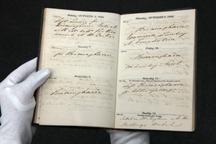

Stephenson, Robert 1803 - 1859
- Nationality:
- English
Robert Stephenson (1803–1859) was a railway and civil engineer born on 16 October 1803 at Willington Quay, near Newcastle upon Tyne, the only son of George Stephenson (1781–1848), colliery and railway engineer.
He was educated at Bruce's academy at Newcastle upon Tyne. On leaving school in 1819 Stephenson was apprenticed to Nicholas Wood, viewer of Killingworth colliery. In 1821 he assisted his father in the survey of the Stockton and Darlington Railway, and then in 1822 spent six months studying natural philosophy, chemistry, and natural history at Edinburgh University. On leaving Edinburgh, Stephenson settled in Newcastle upon Tyne to manage Robert Stephenson & Co at Forth Banks Works, the locomotive building establishment which his father had founded there in 1823 to build stationary and locomotive engines.
The locomotive ‘Rocket’ was built under his direction and went on to win the Rainhill locomotive trials, held in October 1829, to determine the best means of propulsion on the Liverpool and Manchester line. He was responsible for surveying the line of the proposed London and Birmingham Railway and was appointed Chief Engineer. The railway was the world's first intercity passenger railway in which all the trains were timetabled and were hauled for
most of the distance solely by steam locomotives
From 1838 until the end of his life he was engaged on railway work, not only in Great Britain, but all over the world; railways were constructed either under his own direct supervision or under his advice which later became the trunk lines of the countries in which they were laid down. Stephenson’s designs became the dominant type of locomotive in Great Britain. Notable among Stephenson locomotives was the long-boilered engine in which all wheels were placed ahead of the firebox so that there was no restriction on its size. Unsuitable for main line express service, the
type was remarkably successful in the carriage of heavy freight where a reservoir ofsteaming capacity could be used with advantage.
Stephenson was also successful at bridge building, he built the high-level bridge over the Tyne at Newcastle, the Royal Border Bridge at Berwick and the Britannia Bridge over the Conwy and the Menai Strait. Stephenson also proposed the great Victoria Bridge over the St Lawrence River at Montreal, which was begun in 1854 and
completed in 1859 after his death.
On 30 July 1847 Stephenson was elected MP for Whitby. He represented the town until his death.
He died at his home at 34 Gloucester Square, London, on 12 October 1859 and was buried in Westminster Abbey.




